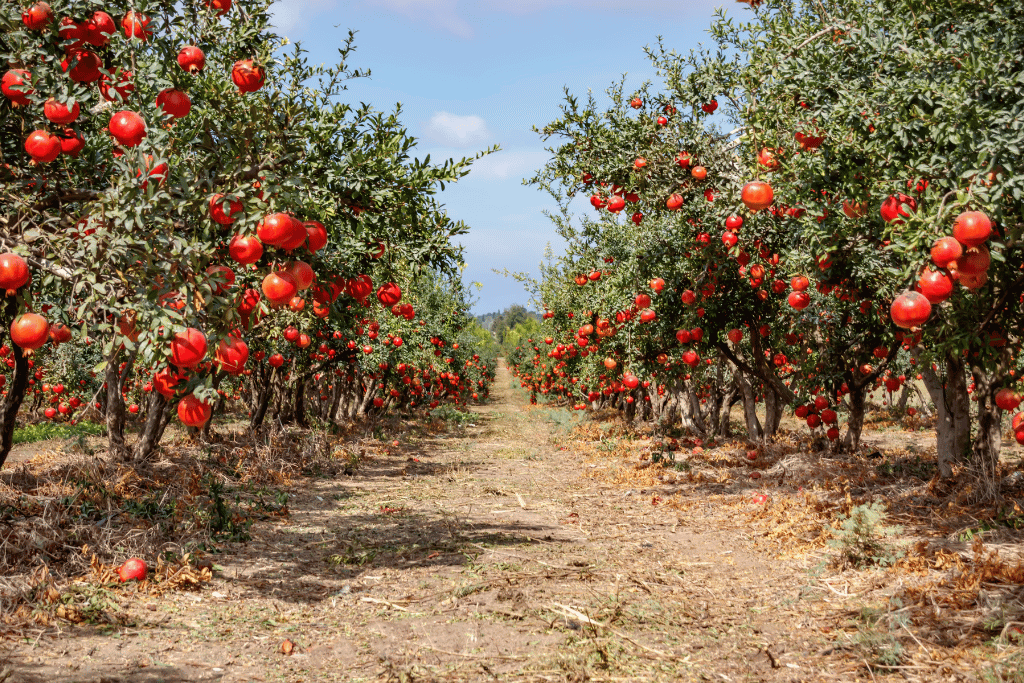
I still remember when I decided to grow my first ever lawn. There I was, standing at the center and wondering – How much grass seed do I need? I had no clue what the sufficient amount was. Lucky for me, I had a mentor with me who taught me how to calculate it right.
Now, if you’re one of those who think, why does the amount even matter? And justify it with more is merrier! Please don’t. You’re destroying your garden before it even comes to life.
It’s essential to get this right because the amount of grass seed you use directly affects the health and appearance of your lawn.
You know, it’s not just about throwing some seeds around and hoping for the best. Calculating the right amount of grass seed is crucial for the success of your lawn. Using too much seed can lead to overcrowding, while using too little might result in a sparse lawn. It’s like Goldilocks and the Three Bears – we want it just right! You get it right?
I’m writing this guide to help you determine the perfect amount of grass seed you need. So that you won’t be asking yourself anymore: How much grass seed do I need?
Let’s get down to it, shall we?
Step#1 – Define Your Goals
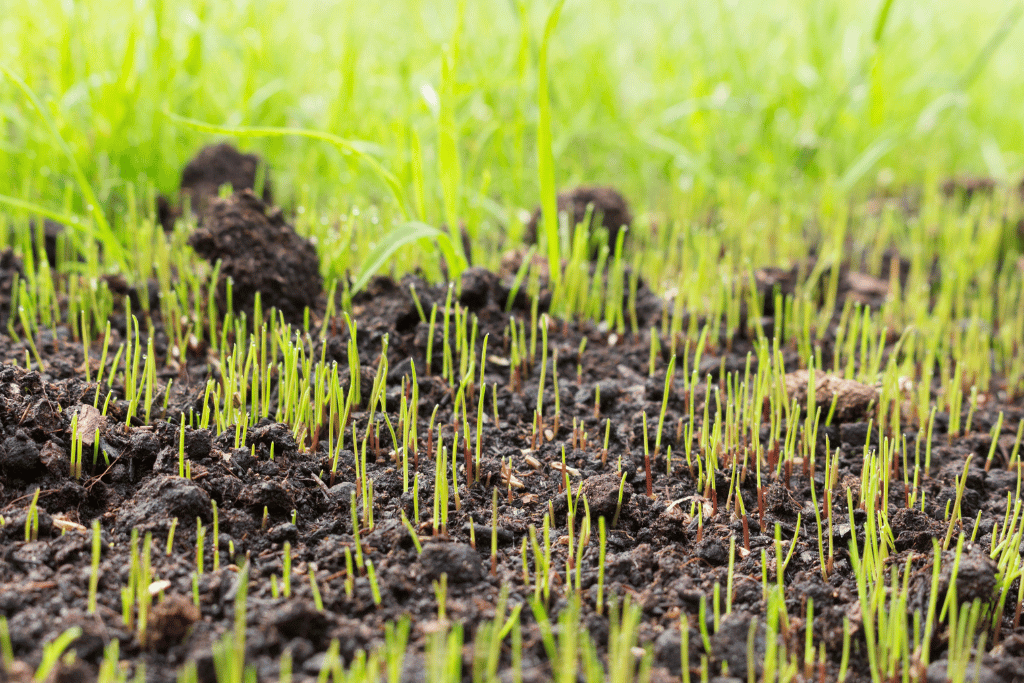
Purpose of seeding
First things first, why are you planting grass seed? Are you starting a brand-new lawn, overseeding to give your existing lawn a boost, or simply patching up some bald spots? Different goals call for different amounts of seed.
Desired grass type
What kind of grass do you want? Cool-season or warm-season? Maybe you have a specific variety in mind. The choice of grass significantly impacts the amount of seed you need.
Expected usage
Is this grassy paradise going to be your backyard haven, a high-traffic sports field, or a business property? The usage matters, as more traffic might require a thicker lawn.
Step#2 – Calculate The Total Square Footage

The next step involves calculating the area. Here’s how to calculate the right amount of grass seed you need for different lawn shapes, including rectangular, circular, triangular, and irregularly-shaped lawns.
1. Calculating for a Rectangular Lawn
For a rectangular lawn, you can use a simple formula to find out how much grass seed is required:
Calculate the Area: Measure the Length (L) and Width (W) of your rectangular lawn. Then use the formula:
Area = Length (L) x Width (W).
For example, if your lawn measures 10 meters in length (L) and 5 meters in width (W), your calculation is straightforward: 10 x 5 = 50 square meters.
Converting Area into Rate of Application: The rate of application for grass seed varies depending on whether you’re establishing a new lawn or overseeding. The standard rates are 35g per square meter for new lawns and 25g per square meter for overseeding.
Calculate the Seed Amount: To determine the amount of seed needed, you multiply the area (in square meters) by the rate of application based on your lawn’s status.
- For sowing a new lawn from scratch: 50m² x 35g = 1750g (1.75kg).
- For overseeding an existing lawn: 50m² x 25g = 1250g (1.25kg).
2. Calculating for a Circular Lawn
Calculating the seed amount for a circular lawn involves some geometry, especially focusing on the concept of Pi (π):
Calculate the Area: Measure the Diameter (D) of your circular lawn. Then, divide the Diameter by 2 to find the Radius (R). Use the formula: Area = R² x π (approximately 3.14).
For instance, if your circular lawn has a diameter of 5 meters:
- Radius (R) = 5m ÷ 2 = 2.5m
- Area = 2.5m² x 3.14 ≈ 19.63m².
Converting Area into Rate of Application: Similar to rectangular lawns, the rate of application remains the same for circular lawns: 35g per square meter for new lawns and 25g per square meter for overseeding.
Calculate the Seed Amount: Multiply the area (in square meters) by the rate of application corresponding to your lawn’s condition:
- For sowing a new circular lawn: 20m² x 35g = 700g.
- For overseeding a circular lawn: 20m² x 25g = 500g.
3. Calculating for a Triangular Lawn
Calculating the seed amount for a triangular lawn is straightforward because a triangle is essentially half of a square or rectangle:
Calculate the Area: Measure the Length (L) and Width (W) of your triangular lawn. Use the formula for calculating the area of a square or rectangle: Area = Length (L) x Width (W). However, since a triangle is half the shape of a rectangle, you need to divide the result by 2 to account for the triangular shape.
For example, if your triangular lawn is 10 meters long and 5 meters wide:
- Area = (10 x 5) / 2 = 25 square meters.
Converting Area into Rate of Application: As with other lawn shapes, you’ll use the standard rate of application for your specific needs: 35g per square meter for sowing and 25g per square meter for overseeding.
Calculate the Seed Amount: Multiply the area (in square meters) by the rate of application according to your lawn’s status:
- For sowing a new triangular lawn: 25m² x 35g = 875g.
- For overseeding a triangular lawn: 25m² x 25g = 625g.
4. Calculating for an Irregularly-Shaped Lawn
If your lawn has an irregular shape, estimating the area becomes a bit more challenging. However, you have two methods to make a close estimate:
Guesstimate the Size: Imagine your irregular lawn as fitting into a square. Calculate the area of that imaginary square using Length (L) x Width (W). Estimate what percentage of that square is covered by lawn (e.g., 75%) and add an extra 5% for safety. Then multiply the estimated area by the rate of application for your specific needs.
Draw a More Accurate Plan: For a more precise measurement, create a scale drawing of your irregularly shaped lawn on graph paper. Count how many squares are fully covered by lawn and how many are partially covered.
Calculate the area by adding the areas of fully covered squares and a portion of the partial squares. Finally, multiply the calculated area by the rate of application for your specific needs.
Remember, when in doubt, it’s better to overestimate than underestimate. Any excess seed can be kept in a resealable, airtight bag to ensure its viability for future use.
Armed with these calculations, you’ll be well-prepared to sow or overseed your lawn with the perfect amount of grass seed for a healthy, vibrant result.
Step#3 (Optional) – Soil Analysis – Delving into the Earth

Note: If you don’t want to get into in-depth technicalities, ignore this step!
The health of your lawn starts with the ground beneath your feet, and understanding your soil is essential to achieving a thriving green carpet.
Why is Soil Analysis Important?
Why bother with soil analysis, you might ask? Well, your soil is the foundation of your lawn, and its condition significantly affects grass growth. Soil analysis reveals essential information, including pH levels, nutrient content, and potential issues such as compaction or drainage problems.
Collecting Soil Samples: The first step in soil analysis is gathering soil samples from different areas of your lawn. These samples should be taken at various spots to ensure that the analysis represents your entire lawn accurately. Use a soil auger or a spade to collect samples from multiple depths, typically up to 6 inches.
Laboratory Testing: To get an accurate analysis, it’s advisable to send your soil samples to a professional laboratory. These labs can provide comprehensive reports on the soil’s pH level, nutrient content, organic matter, and any potential issues such as excessive salinity or contaminants. The data you receive will help you understand the specific needs of your lawn.
Interpreting the Results: Once you obtain your soil analysis report, it’s time to decode the data. You’ll typically receive information on your soil’s pH level, which is critical for nutrient availability. Soil pH is measured on a scale of 0 to 14, with 7 being neutral. Grass typically thrives in slightly acidic to neutral soils, with a pH range of 6.0 to 7.0.
- Adjusting pH: If your soil’s pH is outside the ideal range, you can make amendments to bring it into the desired zone. For instance, if your soil is too acidic, you might need to add lime to raise the pH.
- Nutrient Levels: Soil analysis reports also include data on nutrient levels, such as nitrogen (N), phosphorus (P), and potassium (K). These primary nutrients are essential for healthy grass growth. Understanding the nutrient composition of your soil will guide your fertilization strategy.
- Organic Matter: The report may also indicate the percentage of organic matter in your soil. Adequate organic matter enhances soil structure and fertility, promoting better water retention and nutrient availability.
- Problem Areas: The analysis might reveal problem areas such as excessive salinity, contaminants, or compaction. These issues can impact grass growth and need specific remedies.
Step#4 – Soil Improvement Measures
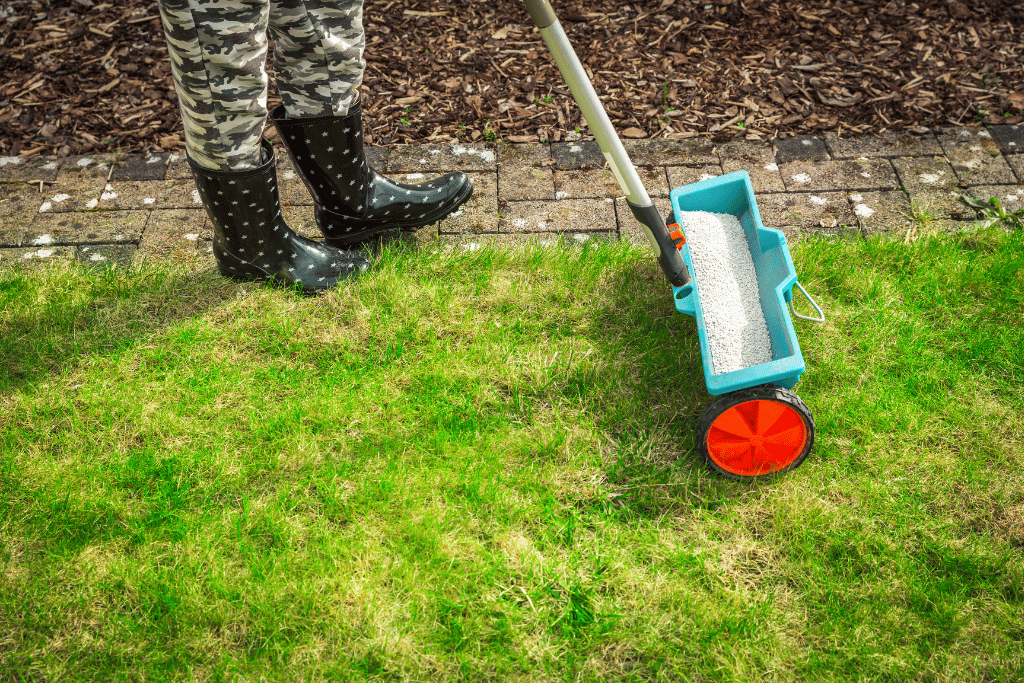
Once you have a clear picture of your soil’s characteristics, you can take targeted actions to improve its condition.
Here are some common soil improvement measures:
Liming:
If your soil is too acidic, liming can help raise the pH to the optimal range. Lime is available in various forms, including dolomitic lime and calcitic lime. The type you choose depends on your soil’s specific needs, as indicated by the soil analysis.
Fertilization:
When you know the soil’s nutrient composition, you can tailor your fertilization plan. Applying the right type and amount of fertilizer ensures that your grass receives the essential nutrients it requires for healthy growth.
Organic Matter Addition:
Increasing organic matter through practices like topdressing with compost or organic mulches can enhance soil structure and water-holding capacity. Organic matter also acts as a slow-release nutrient source.
Drainage Improvement:
If your soil analysis highlights drainage issues, you might need to address this problem by aerating the soil, creating drainage channels, or using soil amendments to improve permeability.
Contaminant Remediation:
If contaminants are detected in your soil, consult with environmental experts to determine the best course of action. This may involve soil removal, remediation, or creating barriers to prevent further contamination.
Customized Care:
With the specific data from your soil analysis, you can create a customized lawn care plan that suits your soil’s needs. This ensures that your grass receives the right treatment, promoting healthy and lush growth.
Seasonal Reassessment
Soil conditions can change over time due to various factors, including weather, lawn care practices, and natural processes. It’s advisable to reassess your soil periodically, especially if you notice changes in your lawn’s health or if you’ve implemented significant soil improvement measures. A follow-up soil analysis will help you track progress and make necessary adjustments to keep your lawn in optimal condition.
Grass Seed Rate Guidelines – Sowing Wisdom
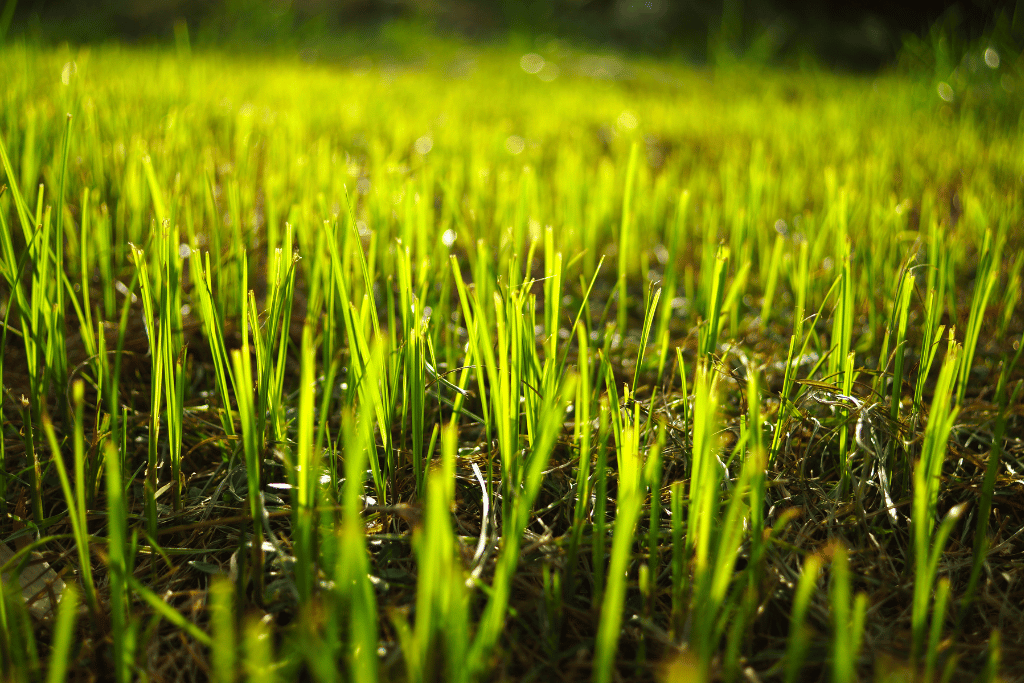
The first step in determining grass seed rate is research. Different types of grass require distinct seeding rates to achieve the ideal lawn coverage. Research is crucial as it helps you select the right grass for your specific needs and climate conditions. Here’s what to consider:
Grass Type: Cool-season and warm-season grasses have different growth patterns. Cool-season grasses thrive in regions with cooler temperatures, while warm-season grasses prefer hotter climates. Research which type suits your area best.
Local Climate Conditions: Consider local environmental factors like average rainfall, temperature, and sunlight. Some grasses are more drought tolerant, while others thrive in wetter conditions. Knowing your region’s climate helps you choose a grass variety that will flourish.
Specific Variety: Within each grass type, there are numerous varieties with varying growth rates, maintenance needs, and appearances. For example, Kentucky Bluegrass is known for its lush, dense growth, while Bermuda grass is drought-resistant and durable.
Account for Seed Germination Rates
One essential aspect often mentioned on grass seed packaging is the seed germination rate. This rate indicates the percentage of seeds that are likely to sprout under ideal conditions. It’s a critical factor in your seeding rate calculation, as it directly impacts the number of seeds you need to sow. Common germination rates range from 80% to 95%, depending on the grass type and seed quality.
For instance, if you have a grass seed with an 85% germination rate, you’ll need to adjust your seeding rate accordingly. To ensure that your lawn achieves the desired coverage, you’ll need to sow a bit more seed than if you were working with seeds that have a 95% germination rate.
Seed Varieties and Mixes
Choosing between a single grass variety or a seed mix is another consideration in your seed rate guidelines. If you decide to use a mix, you’ll need to adjust your calculation to accommodate the ratio of each seed type within the mix.
Suppose, if you’re aiming for a mix of Kentucky Bluegrass, Fine Fescue, and Perennial Ryegrass, you’ll need to calculate the seed rate for each variety based on your desired lawn appearance. This involves considering factors like color, texture, and growth pattern to determine the ideal ratio for your particular vision.
The overall calculation for a mix is a bit more complex, but it essentially involves calculating the individual rates for each grass type within the mix, and then combining them to determine the overall seed rate. This approach allows you to customize your lawn’s characteristics while adhering to recommended seeding rates.
Step#5 – Purchase Quality Seeds Because They are the Heart of Your Lawn!
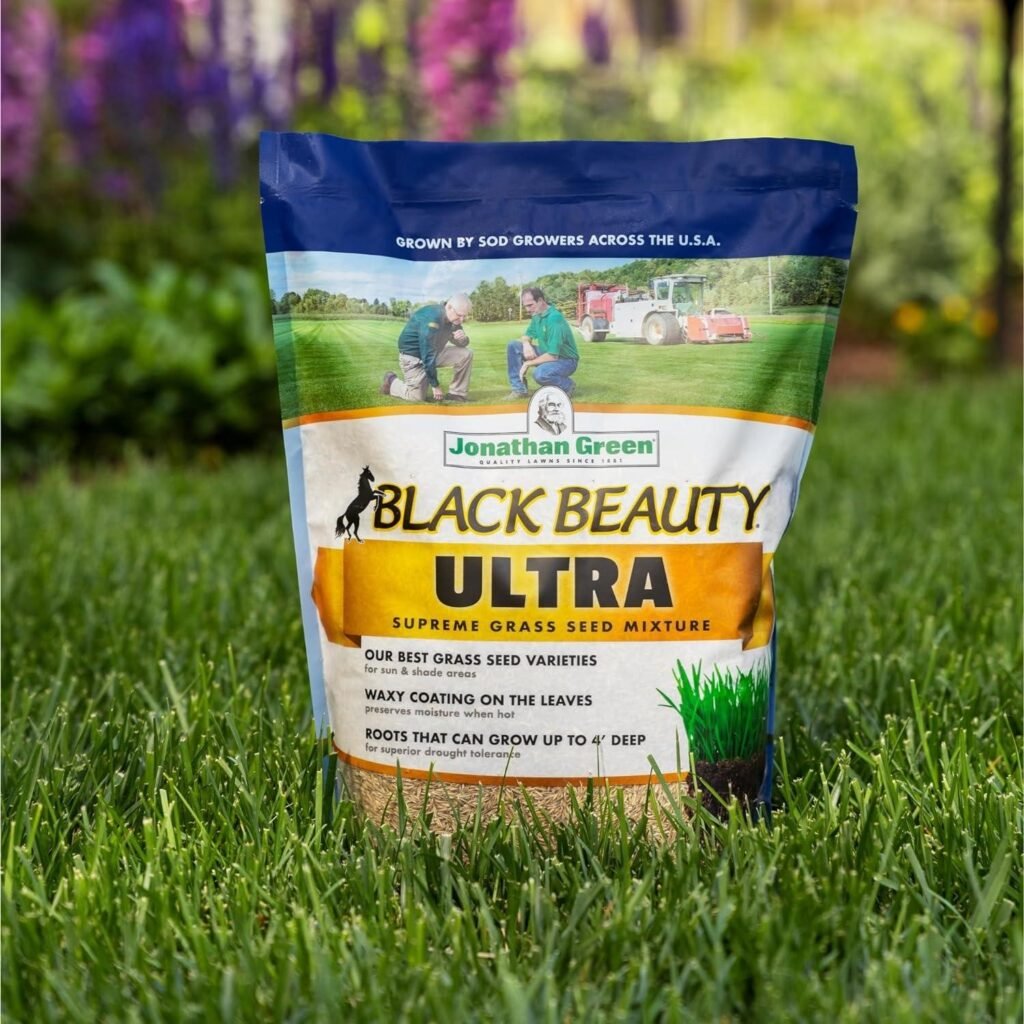
After all the planning and calculations, it’s time to get your hands on the most crucial element of your lawn project – the grass seed. Your choice of seed can make or break the success of your lawn, and one product I’ve personally used and can vouch for is the Jonathan Green Black Beauty Ultra Grass Seed – Cool Season Lawn Seed. Allow me to share my experience with this product.
I recently decided to revamp my lawn, and like any diligent homeowner, I scoured the market for the perfect grass seed. After some research and a bit of expert advice, I stumbled upon the Jonathan Green Black Beauty Ultra Grass Seed – Cool Season Lawn Seed. I must say, it’s been a game-changer for my lawn.
Establishes New Yards & Fills in Bare Spots
One of the most impressive aspects of this grass seed is its speed. It quickly germinated and established a lush, green carpet on my newly seeded areas. Bare spots that were once a sore sight are now brimming with life, invigorating my lawn and turning it into a vibrant paradise.
Provides a Dark Green Lawn
The aesthetic appeal of my lawn has skyrocketed since I began using this grass seed. It delivers a rich, dark-green color that’s not just attractive but also incredibly healthy. The blend of tall fescues, Kentucky bluegrass, and perennial ryegrass creates a dense, lush turf that’s a joy to behold.
Retains Moisture
One of the standout features of Black Beauty Ultra is its water-saving ability. With roots that can delve up to 4 feet deep and a waxy leaf coating, this grass not only retains moisture but also limits evaporation. It’s a particularly valuable trait during hot, dry spells, ensuring that your lawn remains vibrant and green.
Ideal Growing Conditions
I appreciate that this grass seed doesn’t demand an excessive amount of care. It thrives in full sun to partial shade, making it adaptable to various environments. The best time to plant is typically mid-August to mid-October when the ground is warm, and the nights are cooler. I followed this recommendation, and the results were impressive.
Complete Coverage
One bag of Jonathan Green Black Beauty Ultra Grass Seed is more than sufficient for a substantial area. For new lawns, it can seed up to 200 square feet, and for overseeding, it covers up to 400 square feet. The germination time is also quite impressive, with seedlings sprouting within 7 to 14 days, depending on your local conditions.
For me, the Jonathan Green Black Beauty Ultra Grass Seed – Cool Season Lawn Seed has been a fantastic addition. It’s easy to use, provides rapid results, and creates a lawn that’s both visually appealing and healthy.
Step#6 – Seed Distribution – Sowing the Promise
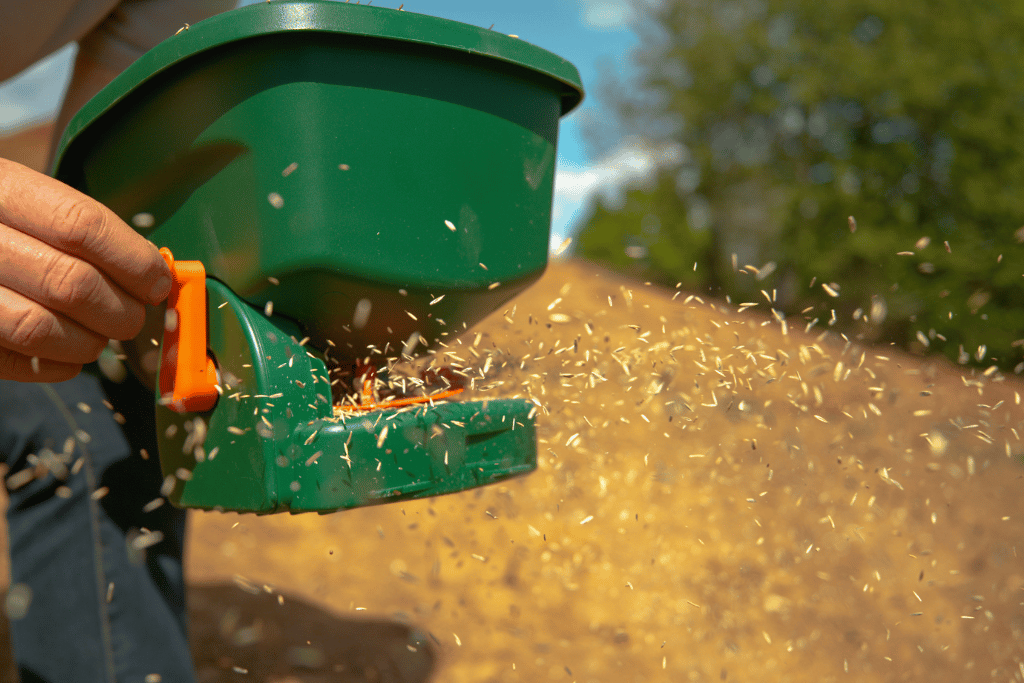
The moment has come to bring your carefully calculated grass seed to life. Let’s explore the methods, techniques, and timing for achieving optimal results.
Divide the Seed for Even Distribution
Before you start sowing, divide your calculated seed amount into manageable portions. This step is crucial to ensure even distribution across your lawn. It also helps you maintain control and prevents overapplication in some areas and underapplication in others.
For example, if you have a large lawn to seed, divide your total seed amount into several portions. You can use containers, buckets, or even mark out sections of your lawn to help you manage the process effectively.
Choose the Right Seeding Method
The method you choose for seed distribution depends on the size of your lawn and your personal preferences. Here are some common seeding methods:
Broadcasting: Broadcasting is a popular method for larger lawns. It involves using a broadcast spreader to evenly disperse the seeds across the lawn. When using this method, remember to adjust the spreader settings to match your desired seeding rate.
Hand Seeding: For smaller lawns or areas that require more precise control, hand seeding is an effective option. It involves manually spreading the seeds evenly by hand. To ensure uniform distribution, divide your lawn into sections and seed one section at a time.
Hydroseeding: Hydroseeding is a professional method that involves mixing the seeds with a slurry of water and mulch, then spraying the mixture evenly across your lawn. This technique is ideal for large areas and provides excellent seed-to-soil contact.
Follow the Recommended Seeding Depth and Timing
To maximize the success of your seed distribution, it’s essential to follow the recommended seeding depth and timing for your specific grass type. Here’s a general guideline:
Seeding Depth: Most grass seeds should be sown at a depth of approximately 1/4 to 1/2 inch. This depth ensures good seed-to-soil contact, which is crucial for germination.
Seeding Timing: The best time to sow your grass seed depends on your grass type. Cool-season grasses are typically sown in the early fall or spring when temperatures are cooler and more conducive to germination.
Warm-season grasses are usually sown in late spring or early summer when the soil is warm and moist.
Covering the Seed: After spreading the seed, lightly rake the soil to cover the seeds with a thin layer of soil or compost. This layer helps protect the seeds from birds, pests, and wind and provides the necessary contact with the soil for successful germination.
Watering Schedule and Requirements
Proper watering is critical after seed distribution. Water your lawn gently but thoroughly immediately after seeding.
Watering helps settle the seeds into the soil and initiates the germination process.
- Initial Watering: After seeding, give your lawn a good soaking to ensure the seeds are well-moistened.
- Daily Watering: Continue to water your lawn daily, keeping the soil consistently moist but not waterlogged. This helps facilitate germination.
- Adjustment: As the grass begins to grow, gradually reduce the frequency of watering and increase the amount of water applied to encourage deeper root growth.
Monitoring and Adjusting
Monitoring your lawn’s progress after seed distribution is crucial. Keep a close eye on the germination process, looking for signs of growth and any areas that may require additional seed. If you notice thin patches or uneven coverage, consider overseeding those areas to ensure complete and lush coverage.
Final Words
So, the bottom line is that calculating the correct amount of grass seed is essential for a healthy lawn. Consider factors like grass type, area size, and local conditions. Proper soil preparation and maintenance are also vital. Achieving a lush lawn is a combination of the right seed amount and good care.



